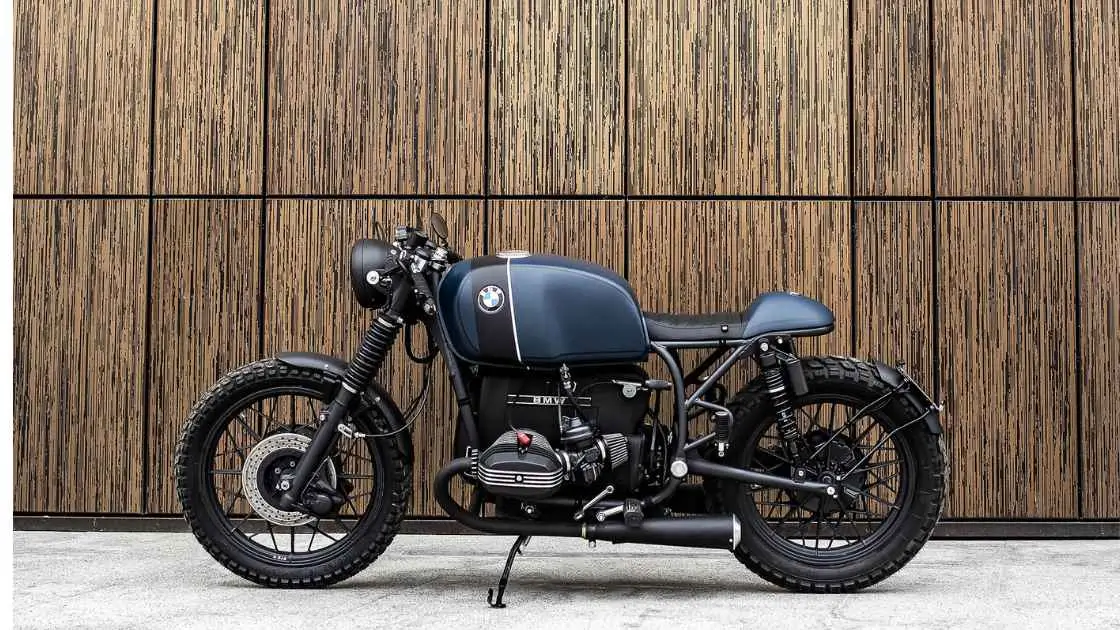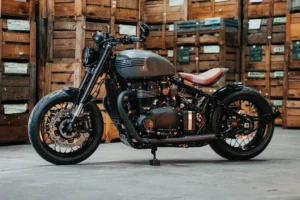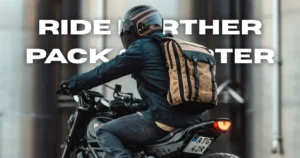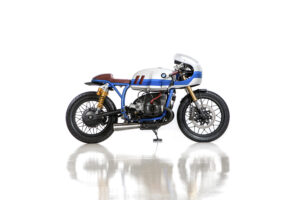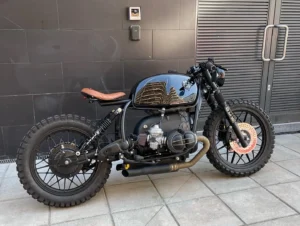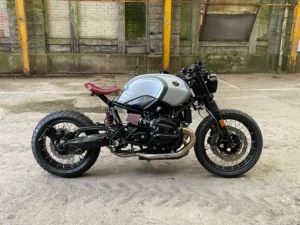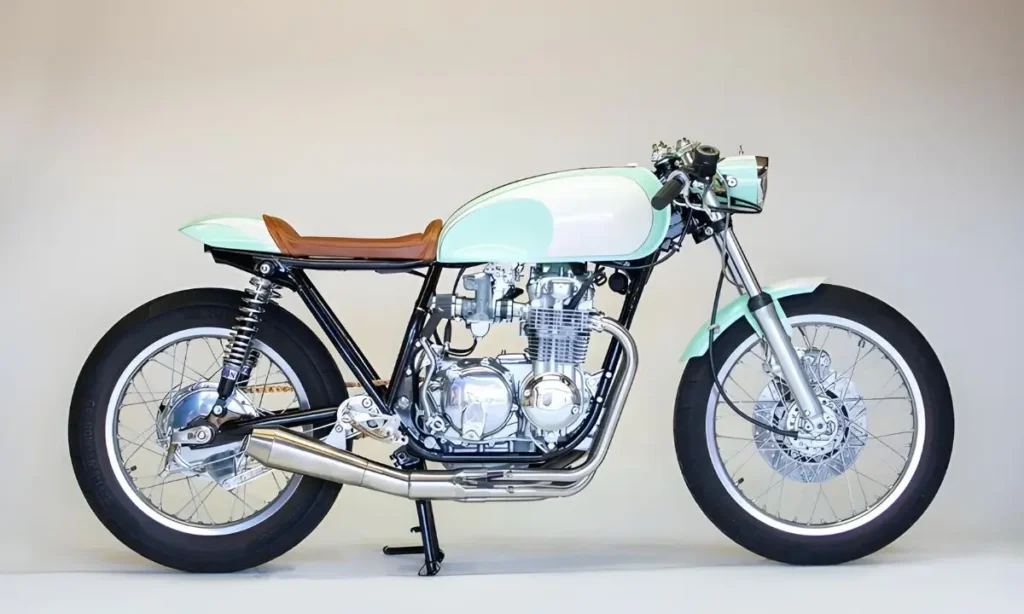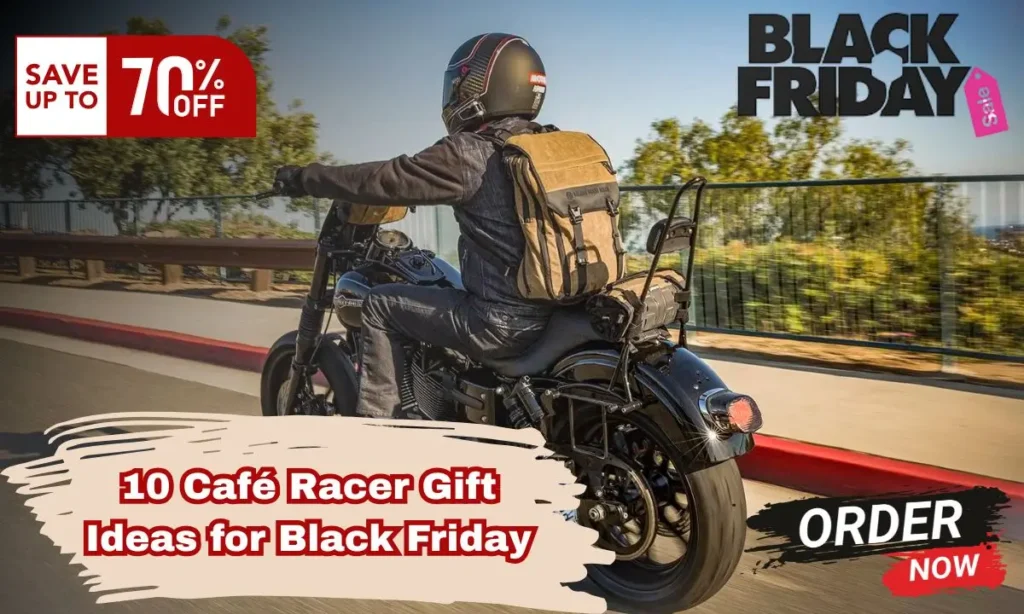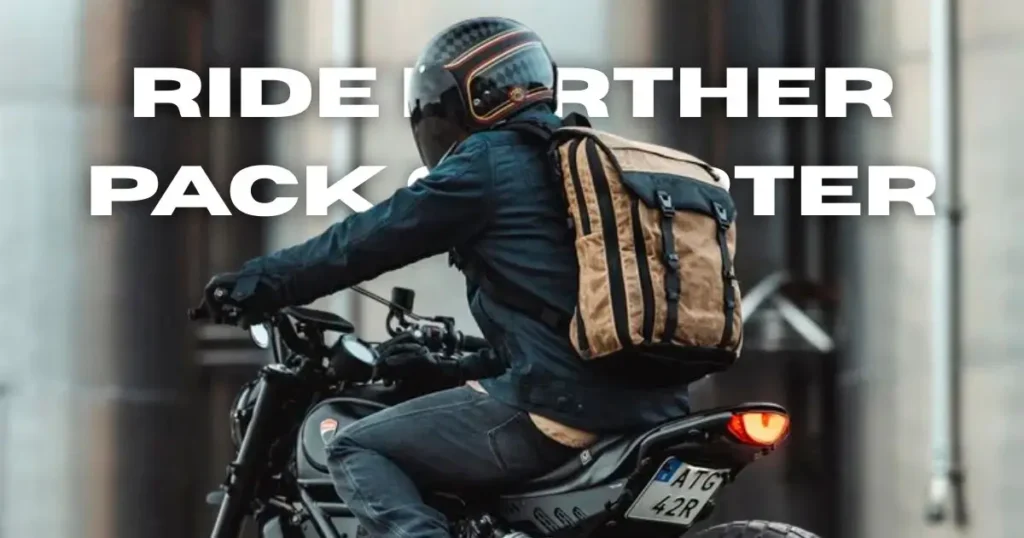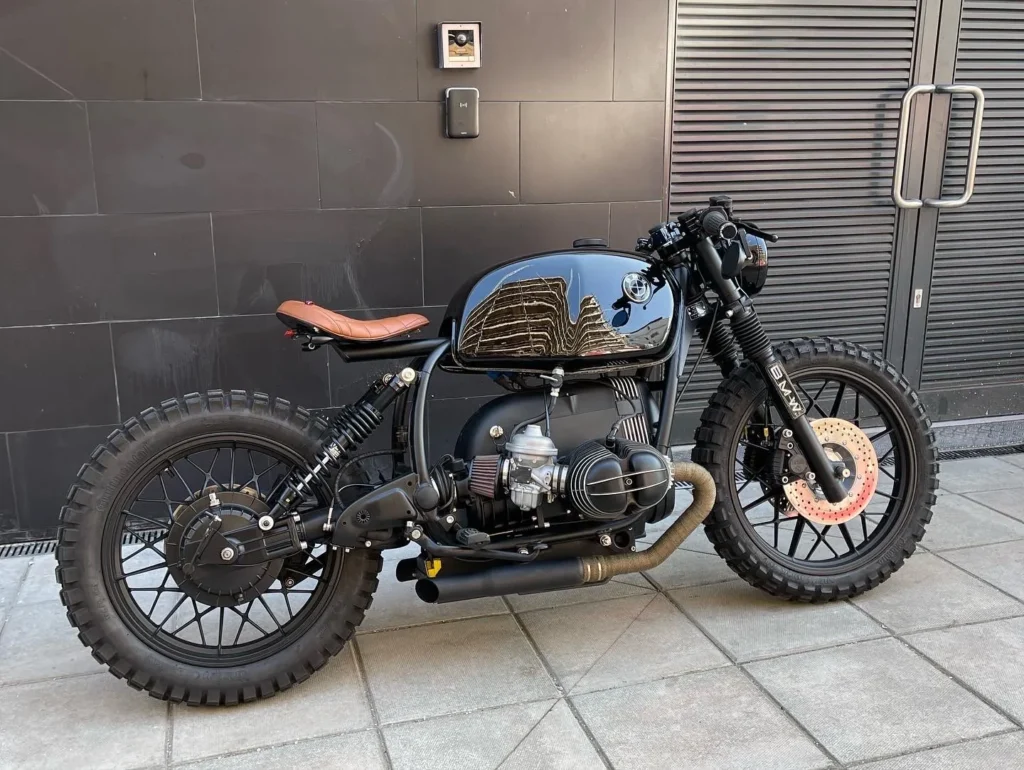Table of Contents
ToggleThere’s something special about taking an old motorcycle like the BMW R100 and turning it into a cafe racer. I didn’t always think I would be so interested in these bikes. But once you learn how the R100 works and how easy it is to customize, it’s hard not to get hooked.
For me, the BMW R100 is not just a motorcycle. It’s a symbol of precise engineering in a simple, timeless design. It’s a bike that is both reliable and flexible. You can make it into anything you imagine. And when you turn the R100 into a cafe racer, you mix old craftsmanship with modern performance upgrades.
In this article, I will share everything I’ve learned about turning a BMW R100 into a cafe racer. I’ll cover its history, how to choose the right parts, and how to take care of it. I’ll share my tips, experiences, and things I wish I knew when I started. Whether you want to build your own or just learn why the BMW R100 is so loved as a cafe racer, I’ve got you covered.
History and Legacy of the BMW R100
The BMW R100 has a history tied to BMW’s promise of quality, trust, and new ideas. If you’re like me, you love a motorcycle with a story, and the R100 has a great one. It first came out in 1976 and quickly became a favorite for people who love touring. What makes the BMW R100 special is how it has changed over time. It started as a touring bike, but now it’s also a top choice for custom cafe racer builds.
BMW R100 Production and Evolution
When BMW made the R100, it was part of their “airhead” series. This name refers to BMW bikes with air-cooled, flat-twin engines. The R100 came in many models, like the R100RS and R100RT, which were made for different types of riding, especially long trips.Learn more about the BMW R100 model variants and how they evolved over the years.
In the early 1980s, BMW made a big change to the R100. They switched from a mechanical ignition system to an electronic one. This made the bike easier to maintain. They also added Nikasil cylinders, which reduced friction and helped the bike stay cool. These changes made the bike more durable. I think these small updates show BMW’s commitment to improving its designs, even when the bike was already known for being reliable.
In the 80s and 90s, BMW kept updating the R100. In 1984, they introduced the Monolever swingarm. This change made the bike more stable by reducing the shaft effect. This happens when the back of the bike lifts during acceleration and lowers during braking. These updates were great for long-distance rides, but they are also popular today with cafe racer fans, who like both style and performance.
The Appeal of the BMW R100 Today
It’s funny to think that a bike made for long, easy trips is now used for cafe racers. The R100 is a mix of old engineering and new potential. The boxer engine, with its unique look and strong power, is famous. What I love most is how you can change it into a simple cafe racer and still keep its true feel.
Today, when you see a custom BMW R100 cafe racer, you’re seeing a bike with years of history. It’s built for today’s roads but keeps its timeless feel, no matter how you customize it.
Why is the BMW R100 ideal for cafe racer builds?
Now, let’s talk about why the BMW R100 is great for a cafe racer build. Once you start looking into it, the reasons are easy to see. I’ve spent time researching and speaking to people who have built these bikes. Everyone agrees: the R100 is like a blank canvas, ready for you to customize.
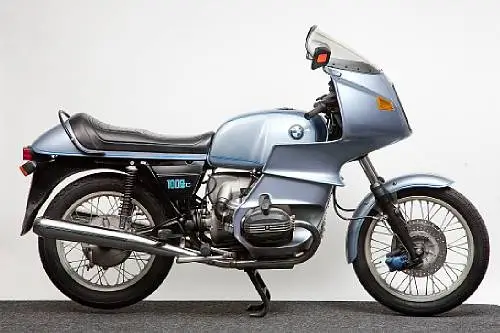
The Boxer Engine: A Mechanical Marvel
The BMW R100 has an iconic air-cooled boxer engine. For those who don’t know, this engine has cylinders that face opposite each other. This gives the R100 its unique look and low center of gravity. What I love most about this engine is how strong and smooth it feels. Whether you’re riding on a quiet Sunday or taking on a twisty road, the engine gives steady power.
The low center of gravity also makes the R100 feel balanced. This is great for cafe racer builds that focus on speed and control. It’s not just about how it looks—this engine makes the ride stable, even at high speeds. Plus, its boxer design stands out, which is a big win for that classic cafe racer style.
Durability and Performance
Builders love the BMW R100 because it is very durable. This bike is made to last a long time. You won’t need to fix it much before you start making changes. Many old R100 bikes are still in good shape even after many years. This is great for building a cafe racer. Instead of worrying about breakdowns, you can enjoy customizing it.
The engine is also easy to upgrade. You can make it perform better with simple changes like new carbs or a lighter flywheel. Builders appreciate that the R100 can speed up without losing reliability. Some even swap the stock exhaust for a custom one to boost airflow and give the bike a better sound.
Aesthetic Potential
Let’s talk about style. It’s a big part of what makes cafe racers special. The BMW R100 looks great for a cafe racer. It’s simple, practical, and cool. When you take off the extra parts, you get a sleek frame ready for changes. You can add different tanks, seats, handlebars, and more, while keeping the stylish look of cafe racers.
One popular change is to replace the original tank with a smaller, vintage one. This gives the bike a tougher look. Builders often lower the handlebars and use clip-ons. This change makes the bike look sportier. Add a custom seat, a shorter rear fender, and some retro tires, and you’ll have a bike that looks fast and rides fast.
Ease of Customization
The BMW R100 is popular in the cafe racer world because it is easy to customize. You can change parts like the seat, tank, and handlebars without a major frame work. There are also many aftermarket parts for the R100, like new exhausts and suspension kits. Whether you are a DIY person or working with a shop, the R100 is affordable to modify.
Even if you are new to bike customization, the R100 is forgiving. You don’t need to be an expert mechanic to make changes. There is also a big community of BMW R100 fans online who share tips, advice, and resources.
Customization Options for BMW R100 Cafe Racers
Customizing a BMW R100 into a cafe racer is a lot of fun. There are many options and parts to choose from, which can feel overwhelming. Costs can add up, too. But if you take it step by step, you will make a bike that is truly yours. Whether you want a simple look or a performance upgrade, focus on these key areas to transform your R100.
1. Engine Upgrades
The engine is the heart of your BMW R100 cafe racer. If you want better performance, there are several ways to boost it.
First, rebuild the engine to get it back to top shape. The original engine is very reliable, but after many years, it might need a refresh. Using lighter pistons, new cylinder heads, and modern seals can help.
Another common upgrade is to change the carburetors. The original Bing carbs are okay, but many builders prefer Mikuni carbs. These can improve throttle response and give the bike more power. Make sure to tune the carbs so they work well together.
Don’t forget the exhaust. A custom exhaust helps with airflow and makes the bike sound great. I love the deep, growling sound from a well-tuned engine with custom stainless steel headers and mufflers.
2. Suspension Modifications
The suspension on the original R100 is good for touring. But if you want to turn it into a cafe racer, you’ll need to make it firmer for better handling and a sportier feel. Many builders start by changing the front forks. You can rebuild the stock forks or swap them for newer ones. Some builders use forks from other BMW models or different brands, like Ceriani replicas, which give you more options to adjust.
At the back, you must upgrade to modern shocks. Aftermarket shocks, like Hagon or Ohlins, offer more ways to adjust and make the ride smoother. This is especially important if you plan to take sharp corners. Whether you choose adjustable suspension or a fixed setup, this change will greatly improve how the bike feels on the road.
3. Exhaust Systems
No cafe racer is complete without a great exhaust. The stock exhaust on the R100 is made for touring—quiet and simple. But for a cafe racer, you need something with more style and sound.
A 2-into-1 exhaust is a popular option. It helps the bike’s airflow, which improves performance. Plus, it gives the bike a cleaner, sharper look. Brands like Hattech and Zard make great exhausts for the R100. Or, if you want something unique, you can have a custom exhaust made.
I like exhausts that not only work well but also look like they belong on an old race bike. Stainless steel or ceramic-coated headers with cone-shaped mufflers give the bike a tough, classic look and also help it run better.
4. Brakes and Wheels
Braking is an important area where you can boost the R100’s performance. Early R100 models came with single-disc front brakes, which might feel weak today. Upgrading to dual-disc Brembo brakes is a popular choice. It makes a big difference in stopping power.
For wheels, many builders choose classic spoked wheels to give the bike a vintage look. Some even swap the rims for Borrani wheels with stainless steel spokes. These look great and are very strong. You can also upgrade the tires for better performance. Bridgestone Accolade tires, for example, give you a retro look with modern grip.
Read More: [Spoke Wheels Vs Alloy Wheels – Which is Better For Cafe Racer?]
5. Bodywork and Aesthetics
This is where you can get creative. A cafe racer is known for its simple, stripped-down style. The BMW R100 is a great bike for that. Builders often replace the large stock tank with a smaller, sleeker one. Some use aftermarket tanks, while others modify the original tank for a more aggressive look.
The seat is another key part of the cafe racer style. Most builders choose a single-seat with a humpback tail, also called a “bum stop.” You can buy a ready-made seat or have one custom-made to fit your bike. I think a hand-made leather seat adds a touch of class to any build.
The subframe is often changed to fit the new seat. Many builders also remove extra parts to give the bike a cleaner, more open look. LED lights are now common in cafe racers, with small headlights and taillights tucked away for a modern but vintage style.
6. Brakes, Controls, and Handlebars
Cafe racers are all about low, aggressive looks. One easy way to get this style is by changing the stock handlebars to clip-ons or clubman bars. These lower the rider’s position and give the bike its classic cafe racer feel. You should also upgrade the controls. Aftermarket levers, grips, and foot pegs can improve both comfort and style.
Notable BMW R100 Cafe Racer Builds
We’ve talked about how to customize a BMW R100 cafe racer. Now, let’s look at some amazing bikes. These bikes show the best in creativity and skill. They push the R100 to new levels while keeping its true spirit.
1. Renard Speed Shop’s BMW R100 Cafe Racer Series
Renard Speed Shop in Estonia makes stunning cafe racer bikes. They take a BMW R100 bike from 1976 to 1979 and change it from top to bottom. They keep the bike’s old charm.
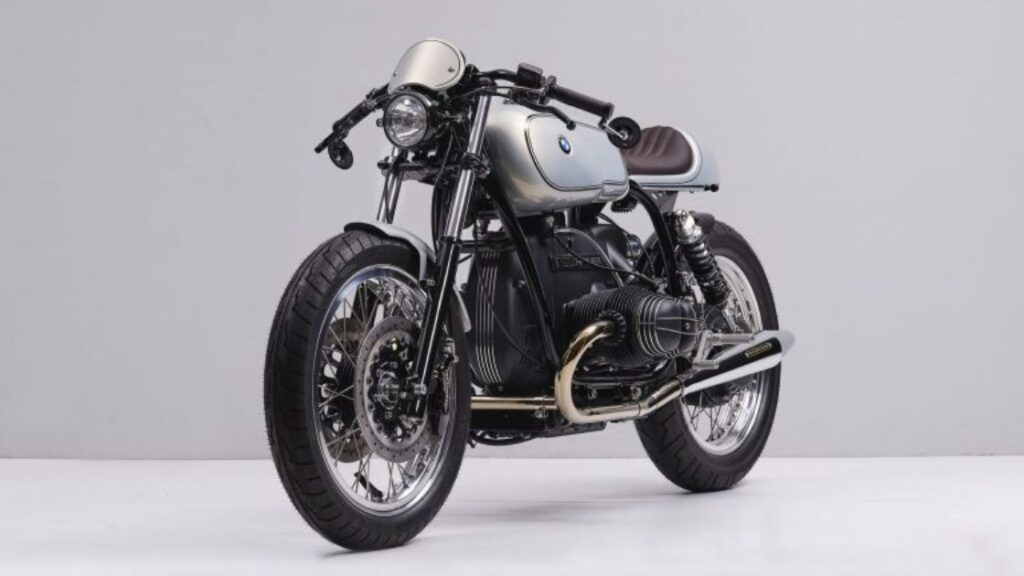
Renard builds bikes with great care. They fix the engine with new, light pistons and better cylinder heads. They also add a new airbox to make the bike run better. But Renard does more. They design the bikes to look simple and cool. They use special tanks, fine wheels, and leather seats made by hand. If you like old-style bikes with new tech, Renard’s bikes are perfect for ideas.
2. Wrench Kings’ “For Her” BMW R100
The Dutch team, Wrench Kings, built a beautiful cafe racer called “For Her.” This bike was made for a woman. It works well and looks great.

I really like this bike because it is good for everyday use and has great features. The builders finished the bike in three months. They made sure it fit the owner perfectly. They changed the bike’s height and made the controls easy to use. They also added nice details that make it fun to ride every day.
They improved the bike with a new exhaust, better carbs, and modern brakes. These changes make the bike reliable and attractive. The final bike is sleek and light. It looks fast even when it’s not moving.
3. Café Racer Dreams’ CRD #58
Café Racer Dreams (CRD) in Spain makes popular custom bikes. Their CRD #58 bike enhances the BMW R100 café racer. This bike, built for a regular customer, stands out while keeping its classic style.
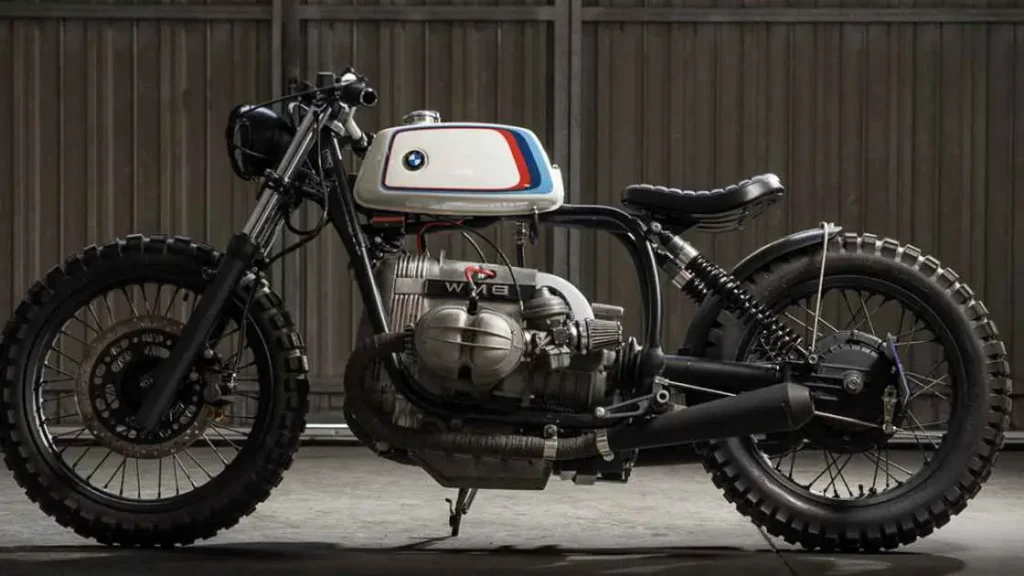
This bike has a special tank not from a BMW. Instead, it’s from a 1972 Puch Minicross, giving the bike a bold, compact look. The builders changed the back part of the bike for one seat. They moved parts and added a custom leather seat. The bike also has modern parts like a keyless start and new lights. These features blend old style with new technology well.
This bike stays true to its roots but adds new features. It’s stylish and works well on today’s roads. It shows you can update a bike while respecting its original spirit.
4. Lord Drake Kustoms BMW R100 DM
The BMW R100 DM by Lord Drake Kustoms is a great mix of cafe racer style and other bike trends. This bike combines elements of cafe racers, scramblers, and bobbers. It looks both old and new.
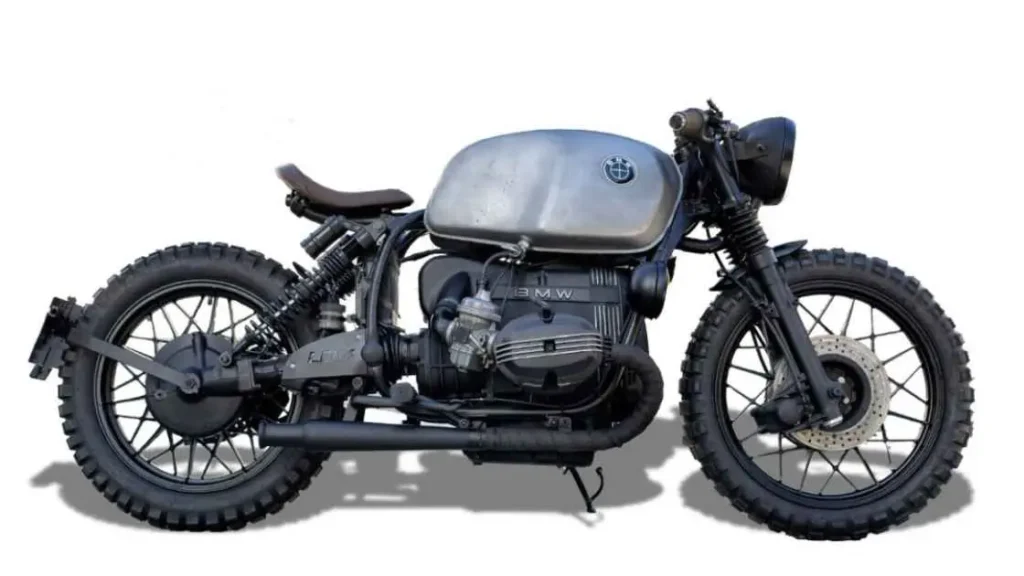
They started by stripping the 1981 R100 to its basics. They changed the front to lower the bike. They added custom fenders, a new seat, and simple lights. These give the bike a unique look. The frame is powder-coated and matte-black, making it tough and flexible in style.
This bike keeps the classic cafe racer feel but adds modern touches. It is both stylish and practical for today’s roads.
5. 46 Works R100RS Cafe Racer
The 46 Works R100RS Cafe Racer is a high-performance bike from Japan. It keeps the sporty feel of the original R100RS and adds new upgrades for better performance.

This bike’s engine is updated with strong pistons. The fuel system is tuned to save gas, and a new exhaust helps it breathe better. It also has better suspension and strong Brembo brakes. This makes the bike great for both racing and street riding.
It looks old but feels new. It has spoked wheels, old-style tires, and a classic BMW look. But, the upgrades make it one of the best cafe racers on the road.
Read More: BMW R100 vs R80 | Which Makes the Best Cafe Racer? [Guide]
Step-by-Step Guide to Building Your Own BMW R100 Cafe Racer
Building your own BMW R100 cafe racer is very rewarding. Once you start, you’ll love it. It’s fun and tough, whether you’re new or experienced. I’ll guide you through the basics, share helpful tips, and warn about common mistakes. This will help you start your own project with confidence.
Step 1: Choosing the Right Donor Bike
Before you build your dream cafe racer, choose the right starter bike. The BMW R100 is a good choice with many models from the 1970s to the 1990s. I suggest picking one that’s well-kept, with little rust and few mechanical problems. A bit of wear is okay. Make sure the bike works or can be easily fixed.
Here are some models to think about:
- BMW R100RS: Known for its covering and good for sporty touring.
- BMW R100RT: Best for long trips and easy to customize.
- BMW R100CS: A sportier model with less extras.
If you’re saving money, you might buy a bike that doesn’t run to use for parts. This is cheaper but needs more work. Starting with a bike in good condition helps you avoid spending too much time and money early on.
Step 2: Budget Planning
Building a cafe racer can be costly, especially with high-quality parts. It’s good to plan your budget before you start. Here’s what you might spend:
- Donor Bike: $3,000 to $6,000, based on condition.
- Performance Mods: $1,000 to $3,000 for engine and carbs.
- Aesthetic Mods: $500 to $2,000 for the seat, tank, and paint.
- Suspension/Brakes: $1,000 to $3,000, depending on the brand and changes.
Your costs will vary depending on how much you do yourself versus outsourcing. If you have some mechanical skills and tools, you can save money. You might handle simpler tasks like upgrading the exhaust or changing the handlebars.
Step 3: Disassembly and Stripping Down
Once you have your donor bike and budget ready, the first step is to strip the bike down. You’ll want to remove all extra parts for a clean, minimalist cafe racer look. Here’s what to do:
- Take off the fairing if your R100 has one.
- Remove the old seat and subframe for a new custom seat.
- Strip off any touring luggage racks or crash bars.
- Replace old lights with smaller, sleeker ones.
Take your time with this phase. Label everything, keep screws and parts organized, and document the disassembly. This helps you put it back together correctly later.
Step 4: Customizing the Frame
A cafe racer like the BMW R100 has a neat and tight look. To do this, you might change the back frame to fit just one seat. You can make a new frame or adjust the old one to fit a shorter seat. It’s important to check that the seat height matches the bike’s style.
Some builders also change the front fork angle for a sharper look. But, this step needs more skills and planning.
Step 5: Installing Performance Upgrades
Let’s talk about making your bike run better. You already have a strong engine with the R100’s boxer. If you want your bike to go faster and smoother, think about these changes:
- Better Carbs: Change the old Bing carbs to new Mikuni ones. This makes your bike faster and smoother when you speed up.
- New Exhaust: A 2-into-1 exhaust sounds great. It also makes your bike run better by letting air flow easier.
- Better Shocks: Put in new shocks or change the front forks. This makes your bike easier to handle. It’s great if you like fast rides.
Remember, a good bike is quick and easy to move. These changes keep your bike looking cool and running well.
Step 6: Crafting the Aesthetic
After fixing the bike’s mechanics, you can make it look cool. You can change the fuel tank, seat, and paint to make your BMW R100 stand out. Here are some ideas:
- Fuel Tank: You can switch the old tank for a new, sharp-edged one. This makes the bike look more bold. Or, you can change the old tank by making it smaller and adding special spots for your knees.
- Seat: Most cafe racers have one seat. You can use a ready-made seat or make one for you.
- Paint Job: Here, you can really show your style. Choose from classic BMW colors or pick bright, new colors to refresh the bike’s look.
Remember, this is your chance to be creative and make your bike unique.
Step 7: Reassembly and Wiring
Now that you have your bike parts ready, it’s time to put the bike back together. This part needs you to be careful and slow. Make sure all the new parts fit right. Take your time to line everything up, try how the parts fit, and check that your cafe racer looks as you planned.
Remember the wires. Many people who build cafe racers use new wiring systems. These systems like the Motogadget m-Unit make your bike look neater. They also let you start your bike without a key and connect to a smartphone.
Step 8: Test Ride and Tweaking
Now that the bike is put together, it’s time for the test ride. Start slow. Notice how the bike feels and moves. Listen for any strange sounds. It’s normal to adjust things after your first ride, especially if you changed the bike’s springs or motor.
Aftermarket Parts and Resources
When building a BMW R100 cafe racer, you need to find the right parts. The aftermarket parts industry is very helpful. You can look for parts to make your bike perform better, look different, or find rare old parts. There are many places to find what you need for your bike. I have spent a lot of time looking at these places. In this part, I will share the best spots to find your parts.
Recommended Parts for BMW R100 Cafe Racers
When you make your R100 bike, some parts are very important for the cafe racer look. Here are key parts and what to check:
1. Exhaust Systems
A great exhaust system not only enhances the bike’s performance but also gives it that deep, throaty sound we all love. You can either go for an aftermarket option or have a custom exhaust made. Some popular exhaust options include:
- Hattech Exhausts: Known for their high-quality stainless steel headers and conical mufflers. They offer systems specifically designed for the BMW R100.
- Zard Exhausts: If you’re after something a little different, Zard produces beautifully designed exhausts that balance performance and aesthetics.
2. Suspension Upgrades
Upgrading your suspension is key to improving handling, especially if you’re planning to ride your cafe racer aggressively. I recommend:
- Ohlins Shocks: They are a premium option but provide excellent adjustability and performance for both street and track use.
- Hagon Shocks: A more affordable option, but still great for modernizing your ride and improving comfort.
3. Clip-on Handlebars and Controls
Low-slung clip-on handlebars are one of the hallmarks of the cafe racer style, and they help lower the rider’s posture for a more aggressive stance. Some brands to look for include:
- Woodcraft Clip-ons: These are adjustable, durable, and widely used in custom builds. They also come in a variety of sizes to match your bike’s front fork diameter.
- Tarozzi Rear Sets: For the foot controls, Tarozzi offers rear sets that allow for more aggressive riding positions, enhancing the cafe racer look and performance.
4. Lighting and Electrical Components
Upgrading the lighting is a great way to modernize your build while keeping that vintage vibe. I recommend checking out:
- Motogadget: These guys are the go-to for modern, high-quality electrical components, including switches, speedometers, and keyless ignition systems. Their m-Unit control unit is widely used in custom builds for simplifying the bike’s wiring.
- LED Lighting Kits: Many builders opt for modern LED headlights and taillights, which are brighter and more efficient. You can find retro-style LED units that match the cafe racer aesthetic.
5. Custom Seats and Tanks
The seat and tank are two areas where your cafe racer will really stand out. You can either find pre-made options or commission a custom job. Here are a few places to source high-quality components:
- Dime City Cycles: They offer a variety of cafe racer parts, including seats, tanks, and handlebars that fit the BMW R100. Their parts are known for their affordability and quality.
- Airtech Streamlining: For those looking to go a step further, they offer custom fiberglass tanks and seat combos that replicate the classic cafe racer style.
Where to Buy Aftermarket Parts
Now you know what parts you need, let’s see where to buy them. Here are some good places I found for BMW R100 cafe racer parts:
1. Dime City Cycles
Dime City Cycles is a great place for cafe racer parts. They have many parts for BMW bikes, like exhausts and custom seats. What I really like is that they have items for any budget, from expensive to more affordable ones.
2. Boxer Metal
Boxer Metal specializes in BMW airheads. If you need custom parts for BMW R100 models, they have a lot. They sell things like rearsets, custom exhausts, and frame changes. They also have a big group of airhead fans, which is great for getting ideas.
3. Motogadget
Motogadget is the best choice for modern electronics for bikes. They make great quality products like speedometers and lights. Their m-Unit makes wiring your bike easier. It’s a bit pricey, but it’s easy to install and very reliable.
4. eBay
eBay is a great place to find old and rare parts. Many sellers have parts for BMW airhead bikes. They offer both new and used parts at good prices. Always check the quality of the parts before you buy them, especially if they are used.
5. Revival Cycles
Revival Cycles is a great place for custom motorcycle parts. They sell high-quality handlebars, tanks, seats, and more. They also have a helpful blog with tips and tutorials for your own projects.
Customization Workshops
If you need help or want to improve your BMW R100 cafe racer, here are some places that specialize in customizing these bikes:
- Renard Speed Shop: They are known for their high-quality BMW R100s. They make a few special bikes and are famous for their fine work.
- Café Racer Dreams (CRD): Located in Spain, CRD builds famous BMW cafe racers. Their bikes are simple and old-style but with new parts for better performance.
- Wrench Kings: In the Netherlands, Wrench Kings focus on custom cafe racers. They are good at making bikes that look great and work well.
Maintenance and Reliability of a Custom BMW R100 Cafe Racer
After you finish building your custom BMW R100 cafe racer, it’s important to keep it in good shape. Even though it’s like a piece of art, it’s still a machine that needs regular care. The BMW R100 is a reliable bike, even with big changes. To make sure it runs smoothly without problems, you need to keep up with its maintenance. I will talk about how to take care of your bike’s engine and electrical system and give some tips to help it stay reliable.
1. Regular Engine Maintenance
The BMW R100 has a strong air-cooled engine that lasts a long time. It has a flat-twin engine that cools down with air. Even though it’s tough, you still need to check and tune it regularly to keep it working well.
- Oil Changes: Change the oil in your engine every 3,000 to 4,000 miles to keep it working well. Use good quality oil made for air-cooled engines like the R100. This bike gets hotter than others, so it’s important to use oil that can handle high temperatures.
- Valve Adjustments: The R100’s boxer engine needs regular valve checks to work well. It’s easy but important. If not done right, it could lower the engine’s performance and cause more wear. You should check the valves every 6,000 miles.
- Carburetor Tuning: If you have new Mikuni carbs on your cafe racer, make sure they are set up right. If they are not adjusted properly, your bike might not run smoothly. It could even hurt the engine over time. Check the tuning regularly, especially if you notice any issues with how the bike runs.
2. Electrical System and Wiring
Many old bikes, like the R100, often have problems with their electrical systems. If you use a new system like the Motogadget m-Unit, it helps a lot. These new systems work much better than the old ones. But, it’s still important to keep everything well-maintained to avoid any electrical issues.
- Battery Care: If you use a lithium-ion battery, watch its charge. These batteries are light and work well but can be sensitive to heat. They also need good care if not used for a while.
- Wiring Inspections: Always check your wiring, especially when riding in tough conditions. Look for wires that are frayed, connections that are loose, or any other damage. If you added extras like LED lights or a keyless start, make sure they work well and don’t have any electrical shorts.
3. Suspension and Brakes
Your brakes and suspension are very important. They keep you safe and comfy. If you updated these parts for your cafe racer, take care of them. This helps them work best.
- Suspension Tuning: Check your shocks, whether Ohlins or Hagon, for wear or oil leaks. If you ride on rough roads or push your bike hard, the suspension will wear faster. It’s important to check and adjust it regularly.
- Brake Pads and Fluids: Keep an eye on your brake pads and fluid levels. Worn pads reduce stopping power and can damage your rotors. Old brake fluid can make your brakes feel soft. Regular checks are especially important if you ride in cities with frequent stops.
4. Tires and Wheels
It’s easy to forget about tire and wheel care when you swap the original wheels for something that looks better. But it’s important to keep your tires in good shape, whether you have spoked Borrani wheels or another custom setup.
- Tire Pressure: Always check your tire pressure before riding. If your tires are under-inflated, the bike will feel sluggish. If they’re over-inflated, you’ll lose grip, especially on wet roads. Use a reliable gauge to check the pressure and keep it within the recommended PSI for your bike.
- Spoke Tension: If you have spoked wheels, regularly check the spoke tension. Loose spokes can cause wobbling, which affects how the bike handles and can be unsafe at high speeds. Tightening the spokes is easy and can be done at home with the right tool.
5. Common Issues and Fixes
Even with careful upkeep, older bikes like the BMW R100 can have some common issues. Here’s what you need to know.
- Shaft Drive Maintenance: The R100 has a shaft-driven final drive, which is low maintenance compared to chain drives. However, you still need to check and service it regularly. This prevents problems like “shaft jacking,” which can affect how the bike handles. Change the drive’s oil as recommended and keep it well-lubricated.
- Overheating: The R100 is air-cooled, so it can overheat in traffic or hot weather. If your bike runs hotter than usual, check the oil level and make sure the carbs aren’t too lean, as this can cause overheating. In hot climates or heavy stop-and-go traffic, consider adding an oil cooler.
6. Keeping the Bike Street Legal
Finally, make sure your cafe racer is street legal, especially if you’ve made big changes. Each area has its own rules for noise, lights, and handlebars. Check these rules before you ride:
- Install DOT-approved tires and lighting.
- Keep the bike registered and up to date with any required inspections.
- Make sure your exhaust complies with local noise ordinances.
Conclusion
Building a BMW R100 cafe racer is more than fixing a bike—it’s a craft. If you’re reading this, you love bikes like I do. Turning an old BMW into a cool cafe racer can change how you see bikes.
This guide has taught you a lot about the BMW R100, from its history to how to make it a cafe racer. You’ve learned about:
- Engine and suspension upgrades that make the bike look and run better.
- Great builds by experts that show the BMW R100’s style.
- Steps to start your own bike, from picking the base bike to adding new parts.
- How to keep your bike in good shape so it lasts long.
What’s great about the BMW R100 is its old charm and new possibilities. Whether you like building bikes or just love custom designs, the R100 gives you many options.
Riding a bike you built is awesome. You know every part of it because you chose it. This makes you feel proud and close to your bike. With the BMW R100, you can do so much.
I hope this guide makes you want to start your own BMW R100 project or love these bikes more. Building a bike is fun, just like riding the finished one. So, pick up your tools and start making your dream bike!
FAQs
Why is the BMW R100 good for a cafe racer?
The BMW R100 is a great choice for building a cafe racer. It has a famous air-cooled engine, which gives the bike a low center of gravity. The engine is smooth and reliable. The bike is also easy to customize because of the many aftermarket parts available. Its simple design makes it perfect for changing both its look and performance.
What are some common upgrades for a BMW R100 cafe racer?
People often make upgrades to the BMW R100 when building a cafe racer. Popular changes include swapping the stock carburetors with Mikuni carbs, adding a 2-into-1 exhaust, and upgrading the shocks with brands like Ohlins or Hagon. Builders also change the gas tank, add clip-on handlebars, and put in a custom seat with a “bum stop” to give it a sporty look.
Is it easy to find parts for the BMW R100?
Yes, it is easy to find parts for the BMW R100. Many shops, like Dime City Cycles and Revival Cycles, sell cafe racer parts for the BMW. You can find parts for both performance upgrades and looks. There is also a large online community of BMW R100 owners who share tips and resources.
What should I look for when choosing a BMW R100 for a cafe racer?
When picking a BMW R100, try to find one in good mechanical shape. Look for a bike with little rust and wear. It’s best to choose a bike that runs well or is easy to fix. Models like the R100RS, R100RT, or R100CS from the late 70s to 90s are good options. They offer both touring abilities and the potential for customization.
How much does it cost to build a BMW R100 cafe racer?
The cost of building a BMW R100 cafe racer depends on the bike and how much you want to change. A donor bike can cost between $3,000 and $6,000. Upgrades like new carbs, exhaust, suspension, and custom parts can add another $2,000 to $6,000. Doing some of the work yourself can help you save money.
What maintenance does a BMW R100 cafe racer need?
A BMW R100 cafe racer needs regular maintenance. This includes changing the oil every 3,000 to 4,000 miles, adjusting the valves, and tuning the carburetor. You should also check the electrical system, especially if you’ve added new parts like a Motogadget m-Unit. Keeping an eye on the suspension, brakes, and tire pressure will ensure safe rides.

